Based in ancient Chinese mythology, Tanabata ‘Evening of the Seventh’ is an annual celebration of the reuniting of the stars Altair and Vega but they have many names.
They are known as Orihime and Hikoboshi or Tanabata and Kengyu in Japan.
Many versions of the legend exist in different parts of the world, but the Japanese celebrate this date (July 7th) with the Star Festival: Hoshi Matsuri (星祭り), each year.
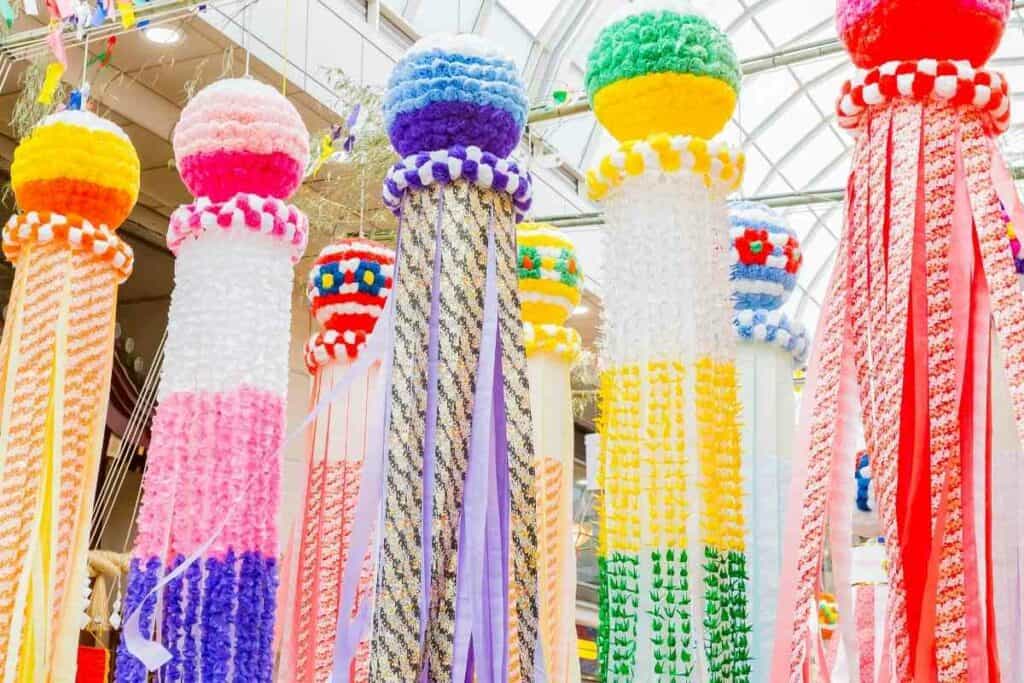
The cross-cultural reach of this legend means that dates vary based on location. Many celebrate throughout August.
Lavishly colourful decorations explode all over Japan, similarly to the adjacent Chinese festival of Qixi (August 4th), at which people ‘plead for skills’.
In This Article – We will guide you through the intricacies of the seven traditional Japanese decorations, their construction and visit the legend itself in order to explain their individual meanings in relation to it.
Table of Contents
Where does the Tanabata tradition come from?
A tradition that is steeped in superstition, Tanabata originates in China and is a cultural adoption into Japanese, along with many other Asian cultures.
The Qixi festival, is a time to worship a Chinese deity known as the seventh elder sister.
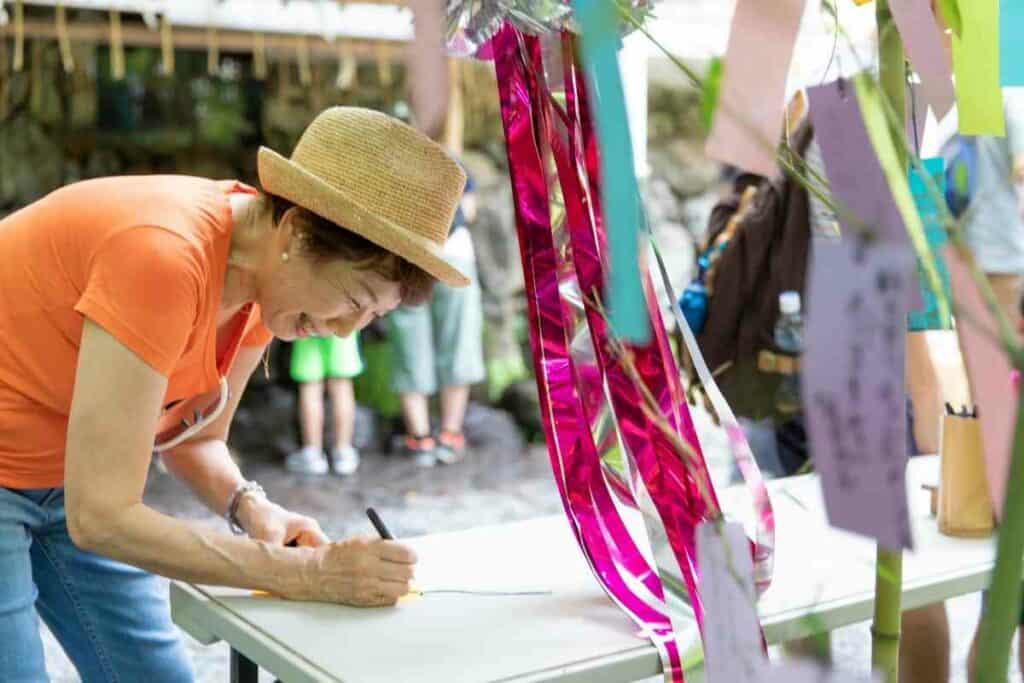
Historically, this would be done on the seventh night of the seventh month but according to the lunar calendar.
Over Time – Focus shifted from the seventh sister to the legend of Zhinu and Niulang, whose names have changed from culture to culture and across time.
The character of a weaver is consistent throughout most adaptations of the tale but sometimes this is an independent character and events may also vary.
A Japanese Legend from China – A Version
Legend has it that two ancient lovers, in the Kingdom of the Heavens, once lived on either side of the river of the Milky Way’s stars.
A lonely weaver and Princess of the Heavens, Orihime, made heavenly garments and worked so hard on them that not only did her loom make beautiful music, but her work also made her feel alone.
Emperor of the Heavens, her father Tentei, knew of a cattle herder who might be a good match for his daughter. She crossed the stars and they fell hopelessly in love.
So engrossed in one another’s company, their skills began to fade. Orihime’s hands could no longer weave the same, and her work suffered.
Her lover, Hikoboshi, forgot how to herd his cattle. Tentei, realising how much this affected them both, decided that from then on they could only see one another once each year.
Only on July 7th, can the lovers reunite, for one night together before returning to their own sides of the Milky Way.
Sasakazari – A Branch of Bamboo
The tradition of attaching a small pieve of paper or card (tanzaku) to a branch of bamboo, along with other decorations, this is also a small decoration or even a child’s toy.
It is often carried by children during the festival.
Hanging tanabata decorations from a severed bamboo branch, these colourful trinkets can be hung as a decoration themselves and you will see many throughout Japan in Summer.
They are even featured in many Japanese computer games and apps, as a collectable.
How are Tanabata decorations made?
Always crafted from paper, these decorations are basically a form of Origami, but the paper is dyed using a Japanese tradition of dyeing which dates back to the 17th century: Yuzen (友禅染).
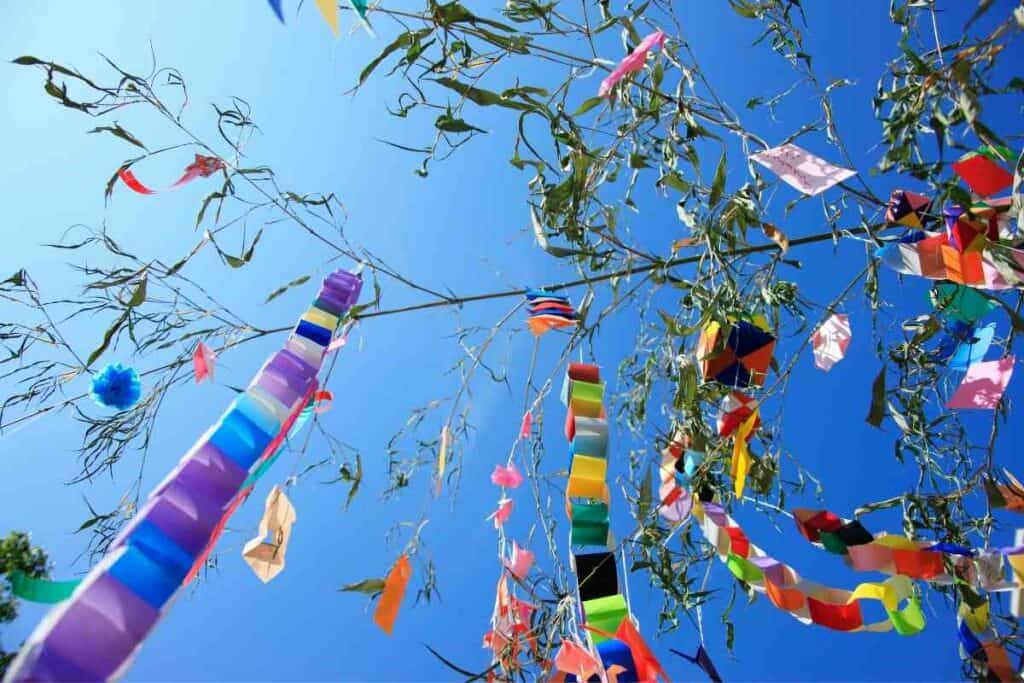
This form of dyeing is used with both paper and fabric and is known as ‘resist-dyeing’ due to the fact that an area of resistance is created within the material, which repels a specific colour and holds the desired colour in place.
This can be wax, or thick stitching but takes various forms, even chemical substances are used. From tiny leaves and boxes to giant streamers, decorations are vastly differentiated.
However, there are 7 essential decorations which are specific to this particular festival.
Each is created to symbolise a specific aspect of Japanese culture, many being miniature paper renditions of everyday Japanese items like kimonos and purses.
Detailed instructions, video demonstrations and even children’s activity packs are easily found for each of these fantastic decorations on the web.
7 Traditional Tanabata Decorations
Linking to the date of the festival itself, lucky number seven holds significance across many cultures.
Tanabata is just one instance of this.
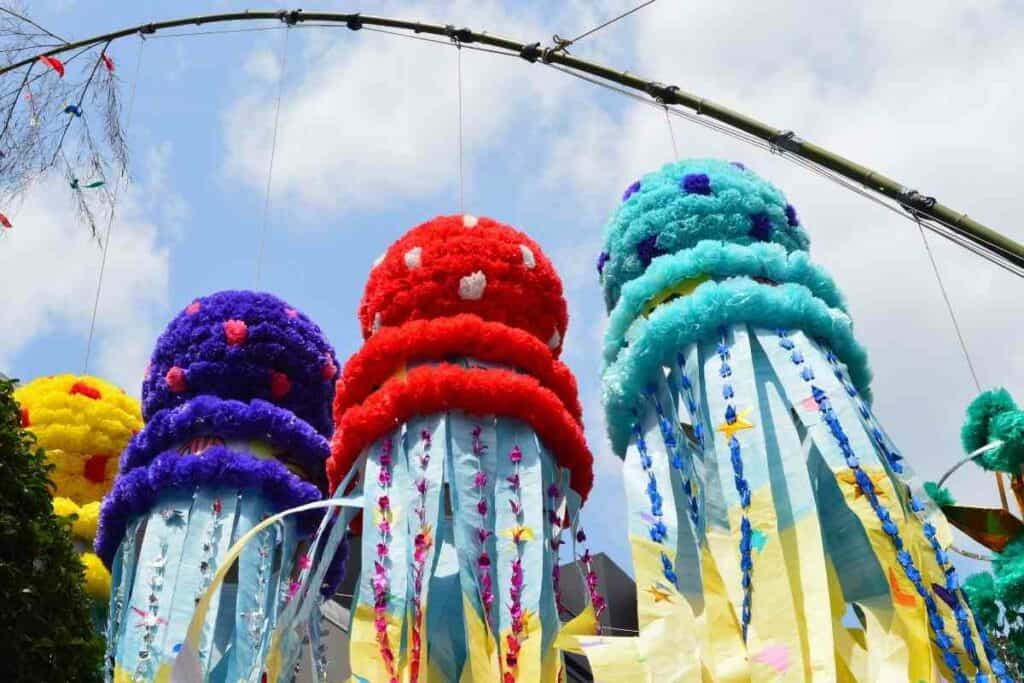
Sources suggest that the number was revered not only due to the ability to rhyme it with the noun ‘heaven’, but also because at one time you could only see 7 (“classical”) planets in the darkness of the night sky.
There are 7 chakras, 7 colours in a rainbow – according to Isaac Newton, even 7 gates to Hell; not to mention the 7 deadly sins.
And, here, are the 7 traditional types of Tanabata decoration.
1. Fukinagashi – Windswept Bonsai (Windsock)
A hanging decoration which is not only colourful but that also symbolically resembles an upside down, windswept bonsai tree.
A decorative windsock, in its most basic form, it consists of an upper spherical segment with streamers attached beneath and is most often made simply from paper.
The streamers represent Orihime’s yarn threads, from which she spins her heavenly garments. These are made in various types.
Some are more detailed, larger structures with multiple blocks attached beneath the spherical “head”.
Streamers are always attached to the end of the lower section, can be many feet in length and up to a few inches in width.
You will find that during the Star Festival, these decorations are hanging from buildings, street signs, and lampposts in most town and city centres, as well as large shopping malls and people’s homes.
The most widely used design originates in Sendai – Origami which resembles the flowering Dahlia – in 1946.
2. Toami – Fishing Net
Being an archipelago, a conglomeration of peninsulas, islands, and islets, Japan is surrounding by the Ocean.
It is no surprise that the art of Fishing is a colossal aspect of the culture.
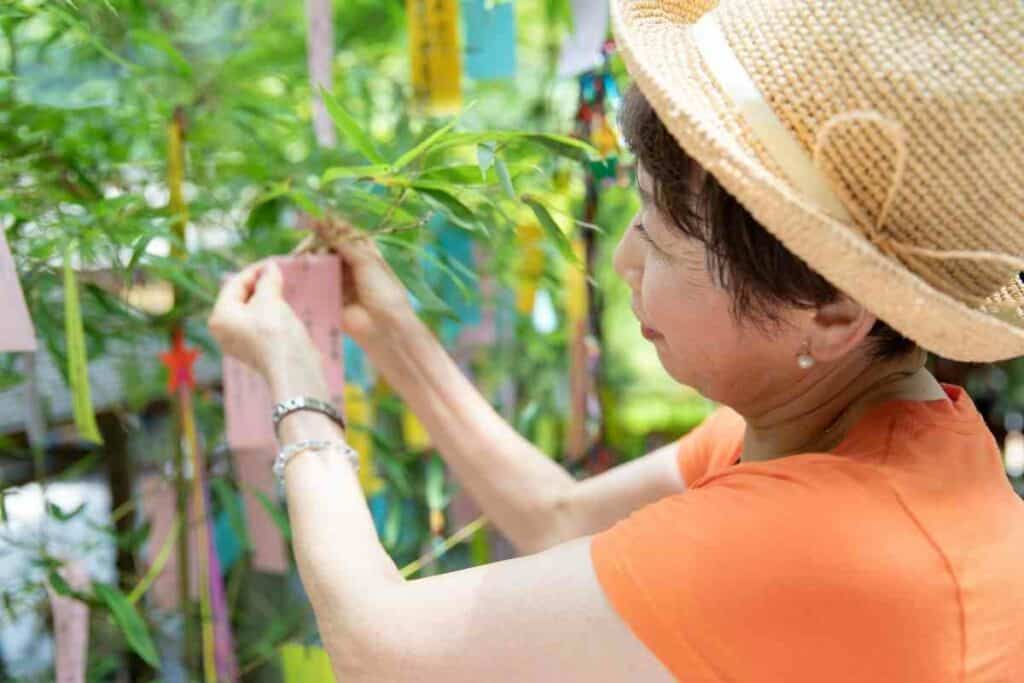
Symbolising Japan’s rich fishing industry, Taomi is crafted to resemble an open fishing net and encourages great fishing and a fruitful harvest.
These can be fiddly to cut but make beautiful additions to the traditional décor.
They are made in a multitude of different types and via a simple folding and cutting process, you can even experiment and design your own unique patterns.
3. Orizuru – Crane
Generally, the Crane is emblematic of many different ideas.
From both Harmony and Grace to the concepts of Beauty, Elegance and even Immortality, this bird is also a shape folded from paper, in all shapes, shades, and sizes.
Revered as one the most famous and popular origami designs, Orizuru is a folded paper crane which symbolises long life, good fortune, and success.
Similar to Tanzaku, it is believed by many that enclosing a wish will produce your heart’s desire.
4. Kamigoromo – Kimono
A paper kimono, Kamigoromo emblematises the ancient skill of Sewing which is rooted in Japanese culture.
Creating this decoration is a plea for improvement in the skill and relates directly to the weaver princess of legend.
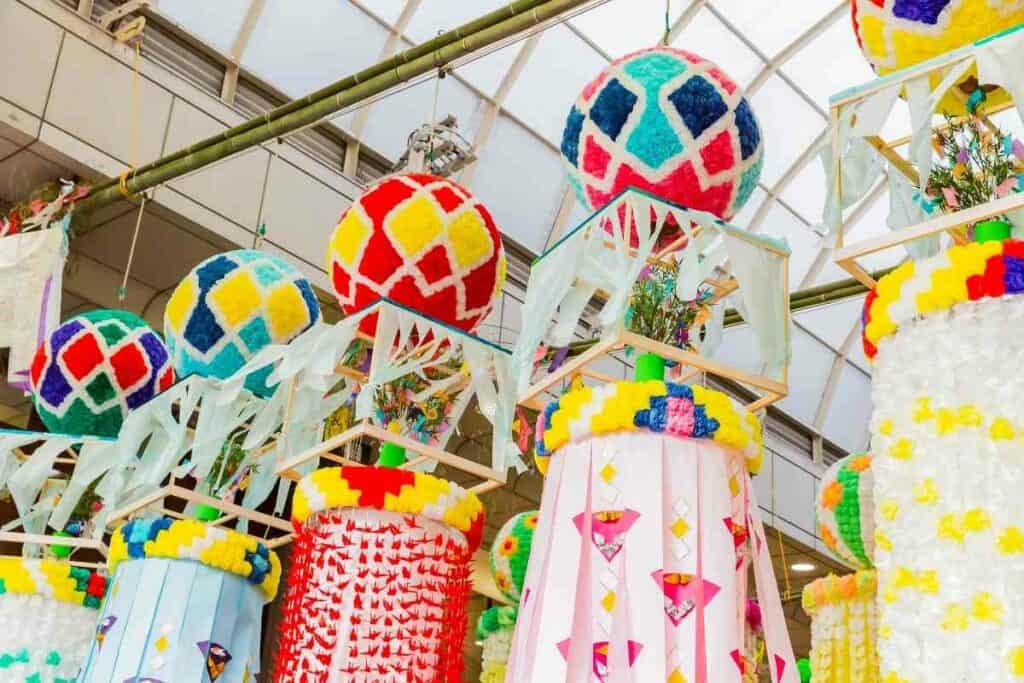
As with the Yukuta itself, these can be made in various sixes, designs, and colours.
It is also believed to encourage healing of the body, mind and soul, along with being a remover of all ill fortunes, a protective layer against them.
5. Kuzukago – Waste Basket
Mari Kondo would be likely to favourite this one!
Staying neat and tidy is something that also relates to the Chinese concept of Feng Shui, living in harmony with one’s environment (to put it simply).
The origami waste basket represents the skill of organisation. It makes a plea for an improvement with staying neat and tidy in your everyday life.
Being organised and living, or even working, in a tidy and efficient environment will reduce stress and ultimately have a real, positive impact on your life – something most Japanese people live by.
6. Kinchaku – Drawstring Purse
Mostly created for prosperity in business, Kinchaku links to wealth.
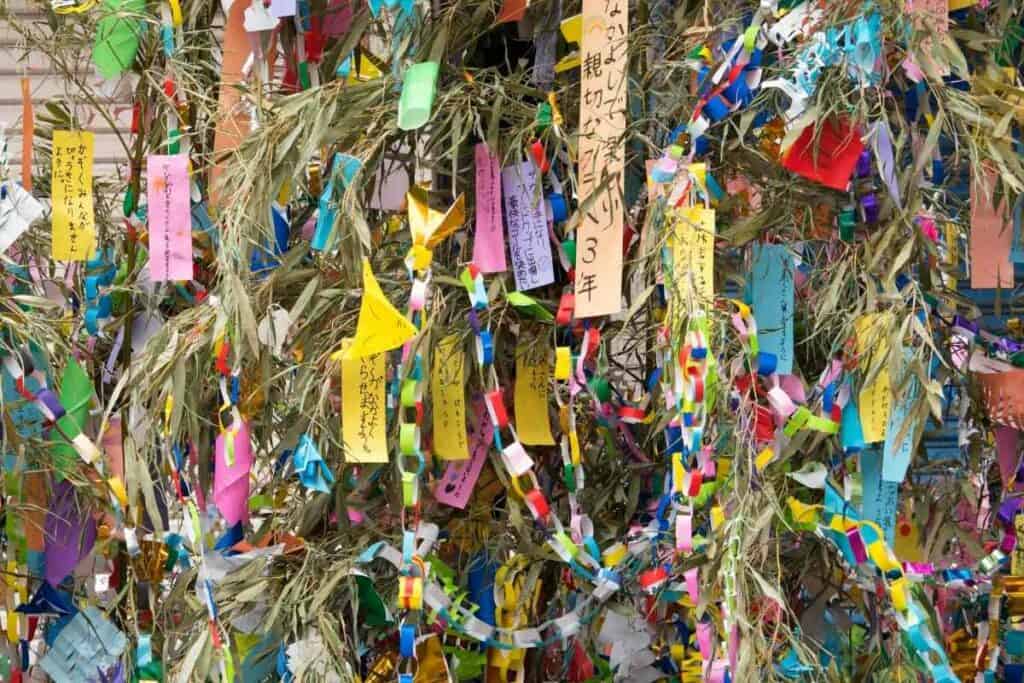
A basic, colourful paper pouch: this basic purse represents financial success and is a mini version of a widely used Japanese handbag, with a similar drawstring rope.
Mobile phone socks are also made this way and small purses to carry money in.
Creating one, like all other Tanabata decorations, is believed to bring you luck with business ventures, making profit or even going for a job interview.
7. Tanzaku – A Written Message
Quite likely the most frequently used of the seven, Tanzaku famously contain a wish.
These small decorations are little rectangular pieces of colourful paper or card which are hung from the branches of bamboo, like the baubles of a Christmas tree.
Often with streamers attached to the end, they were traditionally something on which prayers were written for the reunion of Orihime and Hikoboshi.
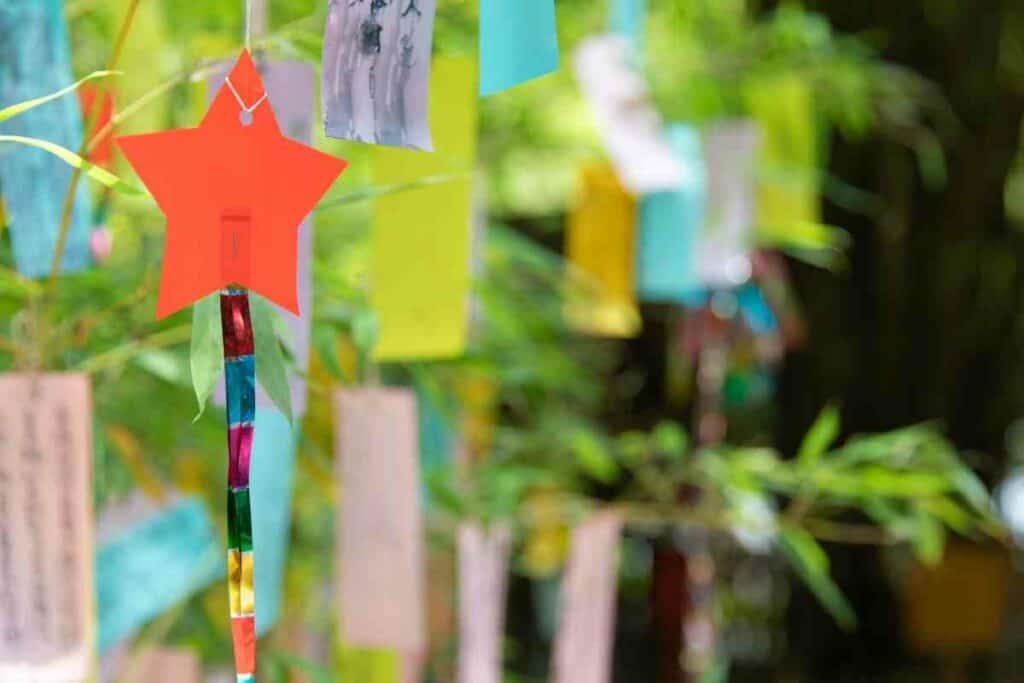
Nowadays, however, the Japanese see these as something much more personal and will write their own prayers or even wishes on them.
Some even use these for the specific appeal for progress in education and writing skills.
Many will hang from one branch and can be accompanied by:
- paper chains
- diamonds
- keys
- mini fukinagashi
- and other decorative crafts
Sendai’s Famous Star Festival – August 6th – 8th
Tanabata is widely celebrated in Japan, but Sendai hosts one of the largest of all Tanabata festivals you will ever see, attracting around two million visitors each year.
Giant fukinagashi decorations dangle in the streets, shops, windows, and walkways, above your head.
The entire city comes together to create an astonishing display of vibrant colours.
Artisans, focusing on one specified task each, form a harmonious production line of collaborative effort and the streets are pervaded with variations of all seven traditional Tanabata decorations.
What do I wear to a Star Festival?
Traditionally, Japanese people will dress up in a summer kimono: a Yukuta during the festival.
These will often be specially made for the festival and will be a lot more brightly coloured than an everyday kimono would be.
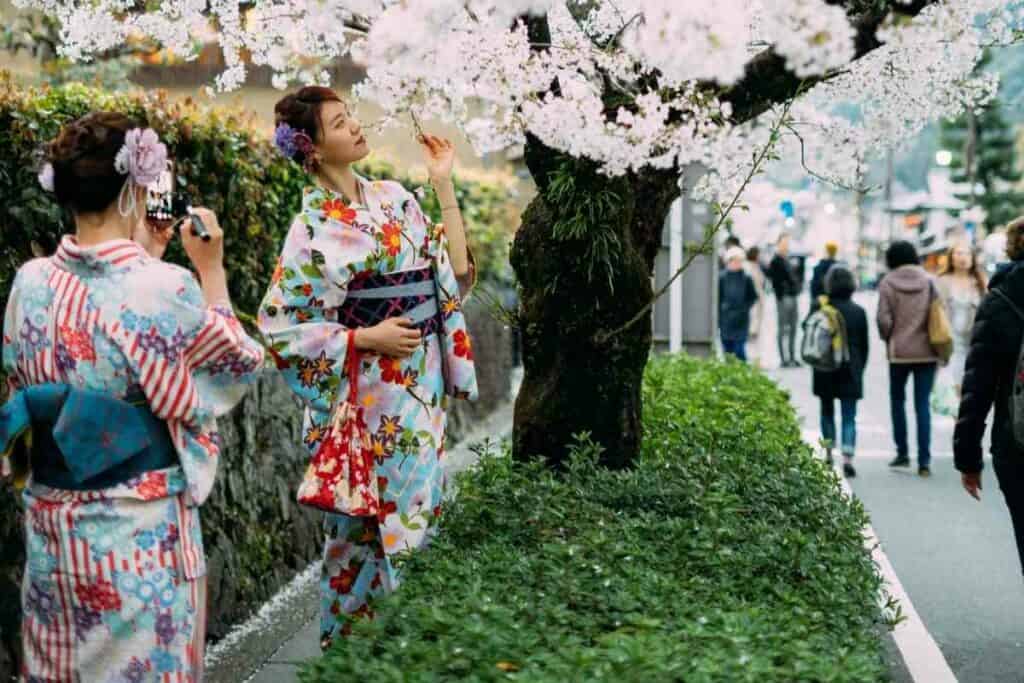
Children will also be dressed this way, carrying a mini set of Tanabata decorations on a small branch of bamboo.
If you’re visiting, feel free to get involved and get yourself a traditional kimono…this, however, is not a requirement.
Final Thoughts
Festivals and celebrations are a massive part of Japan.
Throughout the year, streets are often filled with decorations of some kind, no matter where you are, be it the Hoshi Matsuri or Christmas.
The Japanese take their traditions very seriously and celebrate like no other culture in the world.
Whether you are planning to visit Japan, or you simply have an interest in Japanese culture, creating these Tanabata decorations can be a lot of fun.
Why not have go, yourself? You might even bring yourself some good fortune.
Read Next
- 12 Things Tourists Should NEVER Say in Japan
- Kissing Robot: Exploring the Popularity of the Chinese Kissing App
- Unlocking the Secret Dating Rituals Only Locals Know in Japan
- Samurai Armor: Ancient Protection for Japan’s Elite Warriors
- 10 Amazing Facts About Schools in Japan: Unique Traditions and Educational Practices
- Where can you see snow monkeys in Japan: Best locations and viewing tips









